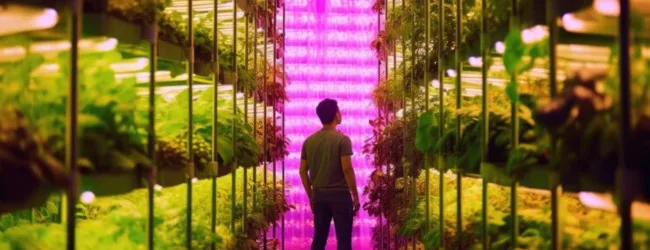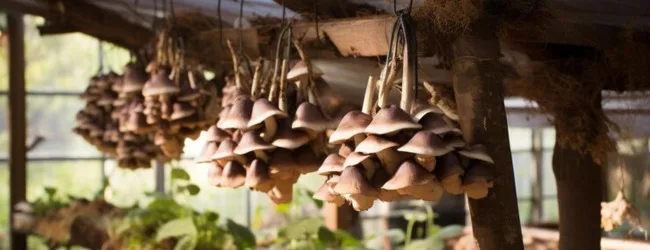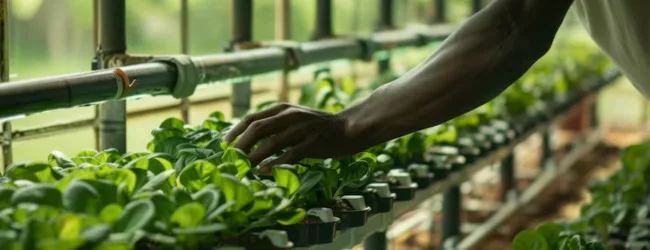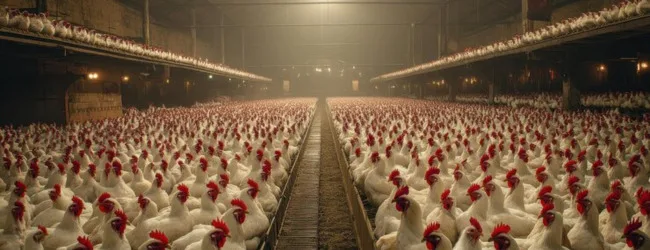Table of contents
- What is Agriculture Business?
- Why Start an Agriculture Business?
- Advantages of Starting an Agriculture Business
- 10 Agriculture Business Ideas
- 1. Organic Farming
- 2. Vertical Farming
- 3. Mushroom Cultivation
- 4. Hydroponics and Aquaponics
- 5. Medicinal and Aromatic Plant Cultivation
- 6. Seed Production
- 7. Beekeeping and Honey Production
- 8. Agro-Tourism
- 9. Small-Scale Poultry Farming
- 10. Value Addition to Agricultural Produce
- Conclusion
- Frequently Asked Questions (FAQs)
India, an agrarian economy, offers a plethora of opportunities in the agriculture sector. With increasing demand for food and a growing focus on sustainable practices, starting an agriculture-based business in 2025 can be highly lucrative. This article explores 10 promising “money-making agriculture business ideas in India” that you can consider.
What is Agriculture Business?
Agriculture business, also known as agribusiness or agri-industry, encompasses all economic activities related to farming and the food sector. It’s a broad term that includes not just the cultivation of crops and raising of livestock, but also the production, processing, marketing, distribution, and retail of agricultural commodities and related products.
Think of it as an entire value chain that starts with the farm and ends with the consumer’s plate. This includes:
- Input Suppliers: Companies that manufacture and sell seeds, fertilisers, pesticides, farm machinery, and other inputs needed for farming.
- Farmers: Individuals or entities involved in the actual cultivation of crops and/or raising of livestock.
- Processors: Businesses that transform raw agricultural products into consumable goods (e.g., food processing plants, dairy processors, textile mills).
- Marketers and Distributors: Companies involved in the storage, transportation, and sale of agricultural commodities and processed foods.
- Retailers: Businesses that sell agricultural products and food directly to consumers (e.g., supermarkets, grocery stores, farmers’ markets).
- Supporting Industries: Businesses providing services like agricultural finance, insurance, research and development, and consulting.
Essentially, agriculture business is about applying business principles and strategies to the agricultural sector to create economic value.
Why Start an Agriculture Business?
There are several compelling reasons why one might consider starting an agriculture business:
- Essential and Growing Demand: Food is a fundamental human need. With a growing global population, the demand for agricultural products is consistently increasing, providing a stable and expanding market.
- Potential for Profitability: While farming can be subject to fluctuations, well-planned and efficiently managed agriculture businesses across the value chain can be highly profitable. Value addition through processing and direct marketing can significantly boost returns.
- Contribution to Food Security: By engaging in agriculture, you directly contribute to feeding communities and ensuring food security, which can be a personally rewarding aspect.
- Rural Development and Job Creation: Agriculture businesses, especially in rural areas, can stimulate economic growth, create employment opportunities, and improve livelihoods.
- Leveraging India’s Agrarian Economy: India has a strong agricultural base, a large workforce, and diverse agro-climatic zones, offering numerous opportunities for various types of agriculture businesses. Government support and policies often favour the agricultural sector.
- Technological Advancements: Modern agriculture is increasingly incorporating technology (precision farming, automation, biotechnology), making it more efficient, productive, and attractive to a new generation of entrepreneurs.
- Growing Focus on Sustainability and Organic Products: The increasing consumer awareness regarding health and the environment creates opportunities for businesses focused on organic farming, sustainable practices, and eco-friendly agricultural products.
- Untapped Potential in Value Chains: There’s significant potential to develop and strengthen various agricultural value chains in India, from farm to fork, reducing waste and increasing efficiency.
- Personal Fulfilment: For individuals passionate about agriculture, nature, and food, starting an agriculture business can be a fulfilling and meaningful career path.
Advantages of Starting an Agriculture Business
Starting an agriculture business can offer several distinct advantages:
- Direct Impact on a Fundamental Need: You are involved in producing something essential for human survival.
- Potential for Independence and Autonomy: Depending on the scale and type of business, you can have significant control over your work and decisions.
- Connection to Nature and the Land: For those involved in farming, it offers a unique connection to the natural environment.
- Diverse Opportunities: The agriculture sector offers a wide range of business opportunities, from traditional farming to high-tech agriculture, food processing, and marketing.
- Government Support and Incentives: Governments often provide subsidies, loans, and other forms of support to the agricultural sector to encourage production and rural development.
- Potential for Scalability: Many agriculture businesses can be scaled up over time with strategic investment and efficient management.
- Resilience to Economic Downturns (to a degree): While not entirely immune, the demand for food tends to be more stable during economic downturns compared to other sectors.
- Opportunity for Innovation: There’s ample scope for innovation in agricultural practices, product development, and supply chain management.
- Contribution to a Sustainable Future: By adopting sustainable farming practices and promoting responsible consumption, agriculture businesses can contribute to a more environmentally friendly future.
- Building a Legacy: A successful agriculture business can be a long-term venture that can be passed down through generations.
10 Agriculture Business Ideas

Here are the 10 Money-Making Agriculture Business Ideas to Start in 2025:
1. Organic Farming

Organic farming isn’t just about avoiding chemicals; it’s a holistic approach to agriculture.
a. Why this Idea :
- Health Consciousness: Consumers are increasingly aware of the harmful effects of pesticides and chemical residues in food, driving a strong preference for organically grown produce. Studies have shown a significant rise in organic food consumption in urban India.
- Premium Pricing: Organic products often fetch 20-50% higher prices than conventionally grown counterparts due to the perceived health benefits and the costs associated with organic certification and lower initial yields.
- Environmental Sustainability: Organic practices build healthy soil, conserve water, and promote biodiversity, contributing to a more sustainable agricultural system in the long run. This aligns with growing global concerns about environmental impact.
- Government Support: The Indian government actively promotes organic farming through schemes like the Paramparagat Krishi Vikas Yojana (PKVY) and the Mission Organic Value Chain Development for 1 the North Eastern Region (MOVCDNER), 2 offering financial assistance and technical support.
b. Licenses Required :
- Organic Certification: This is crucial for authenticating your produce as organic. You can choose between:
- National Programme for Organic Production (NPOP): Managed by APEDA, this certification is essential for exporting organic products.
- Participatory Guarantee System for India (PGS-India): A decentralised system where farmers in a group certify each other, suitable for local markets and direct sales.
- Business Registration: Registering your farm or business as a sole proprietorship, partnership, or private limited company is a fundamental legal requirement.
- FSSAI License: If you plan to process or package your organic produce, you’ll need to obtain a license from the Food Safety and Standards Authority of India (FSSAI).
c. Investment Required :
- Land Conversion: If you’re converting conventional farmland to organic, there’s a transition period (usually 2-3 years) where you can’t sell your produce as certified organic, potentially impacting initial income.
- Organic Inputs: Investing in high-quality organic fertilisers (compost, vermicompost), bio-pesticides, and disease control measures is essential.
- Labour: Organic farming often requires more manual labour for tasks like weeding and pest management.
- Certification Costs: Application fees, inspection charges, and annual renewal fees for organic certification need to be factored in.
d. How to Sell :
- Direct Marketing: Setting up stalls at farmers’ markets, selling through your own website or social media, and organising farm visits can build direct relationships with consumers and fetch better prices.
- B2B Partnerships: Collaborating with organic food retailers, supermarkets with organic sections, and restaurants that prioritise organic ingredients can provide a stable sales channel.
- E-commerce Platforms: Several online platforms in India specialise in selling organic produce, providing wider market access.
- Export: With NPOP certification, you can explore international markets for organic products.
e. Any other Requirements :
- Soil Health Management: Regular soil testing and implementation of practices like crop rotation and cover cropping are vital for maintaining soil fertility.
- Water Management: Efficient irrigation techniques and water conservation are crucial in organic farming.
- Pest and Disease Management: Implementing integrated pest management (IPM) strategies using natural methods is key.
f. Challenges in the Idea :
- Yield Fluctuations: Initial yields during the transition phase might be lower compared to conventional farming.
- Market Access: Connecting with the right buyers and establishing a reliable supply chain can be challenging.
- Price Competition: While organic produce commands a premium, competition within the organic market is also increasing.
g. How to overcome the Challenges :
- Phased Transition: Converting land in stages can help manage income flow during the transition period.
- Building Networks: Actively participating in organic farmer associations and connecting with potential buyers early on is important.
- Value Addition: Processing organic produce into products like jams, pickles, or flours can increase profitability and reduce dependence on fresh market prices.
Okay, let’s proceed with the detailed explanations for the remaining nine “money-making agriculture business ideas in India” for 2025, following the same structure.
ALSO READ – Top 7 Farming Business Ideas That Will Boom in India by 2025
2. Vertical Farming

Vertical farming offers a modern, space-efficient approach to agriculture.
a. Why this Idea :
- Urban Food Security: With increasing urbanisation and limited arable land, vertical farming provides a solution for producing fresh food closer to urban centres, reducing transportation costs and ensuring food security.
- Year-Round Production: Controlled environment agriculture (CEA) within vertical farms allows for consistent production regardless of external weather conditions, ensuring a stable supply.
- Resource Efficiency: Vertical farms typically use significantly less water (up to 90% less than traditional farming) and eliminate the need for pesticides and herbicides, contributing to sustainable resource management.
- High Yields: By optimising growing conditions and plant density, vertical farming can achieve significantly higher yields per unit area compared to conventional farming.
b. Licenses Required :
- Business Registration: Registering your vertical farming operation is essential.
- Environmental Permits: Depending on the scale and location (especially in urban areas), you might need environmental clearances related to water discharge, waste management, and energy consumption.
- Food Safety Licenses (FSSAI): If you are selling edible produce, obtaining an FSSAI license is mandatory to ensure food safety standards are met.
- Electricity Connection: A reliable and potentially high-capacity electricity connection is crucial for powering lighting, climate control, and other systems.
c. Investment Required :
- Infrastructure Setup: The major investment lies in setting up the vertical structures, growth trays, lighting systems (LED grow lights are common), climate control (HVAC, humidity control), and hydroponic/aquaponic/aeroponic systems.
- Technology Costs: Depending on the sophistication of your system (e.g., automated nutrient delivery, environmental monitoring), technology costs can be significant.
- Energy Costs: Maintaining optimal temperature and lighting can lead to substantial energy consumption, a major operational cost.
- Skilled Labour: Operating and maintaining a vertical farm requires skilled personnel with knowledge of plant science, hydroponics/aquaponics, and system maintenance.
d. How to Sell :
- Direct Supply Agreements: Partnering with high-end restaurants, hotels, and catering services that value consistent quality and locally sourced produce.
- Retail Partnerships: Supplying to premium supermarkets and grocery stores in urban areas.
- Online Sales and Delivery: Establishing your own e-commerce platform or partnering with online grocery delivery services to reach urban consumers directly.
- Subscription Boxes: Offering weekly or monthly subscription boxes of fresh produce to local residents.
e. Any other Requirements :
- Technical Expertise: A strong understanding of plant physiology, nutrient management, and the chosen vertical farming technique is crucial.
- Controlled Environment Management: Maintaining precise control over temperature, humidity, light, and CO2 levels is essential for optimal plant growth.
- Water Quality Management: Ensuring the nutrient solution in hydroponic systems or the water quality in aquaponic systems is vital.
f. Challenges in the Idea :
- High Energy Consumption: The cost of electricity for lighting and climate control can significantly impact profitability.
- Technical Complexity: Managing and troubleshooting the sophisticated systems requires specialized knowledge.
- Initial Capital Investment: The upfront cost of setting up a vertical farm can be a significant barrier to entry.
- Market Education: Educating consumers about the benefits and value of vertically farmed produce might be necessary.
g. How to overcome the Challenges :
- Energy Efficiency: Investing in energy-efficient LED lighting, optimising climate control strategies, and exploring renewable energy sources (like solar power) can reduce energy costs.
- Training and Expertise: Hiring skilled personnel or investing in thorough training for your team is essential.
- Phased Investment: Starting with a smaller, modular system and scaling up gradually can help manage initial capital outlay.
- Highlighting Benefits: Emphasising the freshness, quality, sustainability, and local origin of your produce can justify premium pricing.
3. Mushroom Cultivation

Mushroom cultivation is a relatively low-space, high-potential agri-business.
a. Why this Idea :
- High Nutritional Value: Mushrooms are a rich source of protein, vitamins, and minerals, making them a healthy food option with increasing consumer demand.
- Short Growth Cycle: Many popular mushroom varieties, like oyster mushrooms, have a relatively short cultivation cycle (weeks rather than months), leading to quicker returns on investment.
- Substrate Availability: Mushrooms can be grown on various agricultural wastes like straw, sawdust, and corn cobs, turning waste into a valuable resource and reducing environmental impact.
- Low Space Requirement: Indoor cultivation allows for efficient use of space, making it suitable for small landholdings or even urban environments.
b. Licenses Required :
- Business Registration: Registering your mushroom cultivation business is the first step.
- FSSAI License: If you are selling fresh or processed mushrooms, obtaining an FSSAI license ensures adherence to food safety standards.
- GST Registration: Depending on your turnover, Goods and Services Tax (GST) registration will be required.
c. Investment Required :
- Growing Room Setup: This includes creating a controlled environment with appropriate temperature, humidity, and ventilation. This can range from a simple shed to a more sophisticated climate-controlled room.
- Spawn Purchase: High-quality mushroom spawn (the “seeds” of mushrooms) is a crucial input cost.
- Substrate Procurement: The cost of the growing medium (straw, sawdust, etc.) needs to be considered.
- Basic Equipment: Trays, bags, watering cans, and cleaning supplies are necessary.
d. How to Sell :
- Local Markets: Selling fresh mushrooms directly at local markets and to individual consumers.
- Restaurants and Caterers: Supplying fresh mushrooms to restaurants and catering services.
- Grocery Stores: Partnering with local grocery stores and supermarkets.
- Value-Added Products: Processing mushrooms into dried mushrooms, mushroom powder, pickles, or ready-to-cook mushroom kits can increase profitability and shelf life.
e. Any other Requirements :
- Knowledge of Cultivation Techniques: Understanding the specific requirements for the chosen mushroom variety (temperature, humidity, substrate preparation, etc.) is essential.
- Hygiene and Sanitation: Maintaining a clean and hygienic growing environment is crucial to prevent contamination and diseases.
f. Challenges in the Idea :
- Contamination: Mould and other contaminants can quickly ruin a mushroom crop.
- Maintaining Optimal Conditions: Precise control of temperature and humidity is vital for successful cultivation.
- Limited Shelf Life: Fresh mushrooms have a relatively short shelf life, requiring efficient marketing and sales.
- Market Competition: Depending on your location, you might face competition from established mushroom farms.
g. How to overcome the Challenges :
- Strict Hygiene Practices: Implementing thorough cleaning and sanitation protocols in the growing area.
- Climate Control: Investing in basic climate control measures like ventilation and humidity control.
- Efficient Marketing: Developing a strong network of buyers and exploring preservation techniques or value-added processing.
- Focusing on Quality: Producing high-quality mushrooms consistently can help build a strong reputation and customer loyalty.
💡 Pro Tip: If you want to start a Business but have too many doubts, connect with a Business expert from Boss Wallah for guidance – https://bw1.in/1116
4. Hydroponics and Aquaponics

These soilless farming techniques offer unique advantages.
a. Why this Idea :
- Water Conservation: Hydroponics uses significantly less water than traditional agriculture, and aquaponics further enhances efficiency by recycling water between fish and plants.
- Higher Yields and Faster Growth: Optimised nutrient delivery and growing conditions can lead to faster growth rates and higher yields per unit area.
- Reduced Pesticide Use: Growing in a controlled environment minimises the need for pesticides and herbicides.
- Urban Applicability: These methods are well-suited for urban and peri-urban areas where land is limited.
b. Licenses Required :
- Business Registration: Essential for any formal business operation.
- FSSAI License: Required for selling edible produce to ensure food safety.
- Aquaculture License (for Aquaponics): Depending on state regulations and the scale of fish farming, an aquaculture license might be necessary.
- Environmental Permits: Depending on the scale and location, permits related to water usage and discharge might be required.
c. Investment Required :
- System Setup: The cost of setting up hydroponic systems (nutrient films technique, deep water culture, etc.) or aquaponic systems (fish tanks, grow beds, pumps, plumbing) is the primary investment.
- Growing Medium (for some hydroponic systems): While soil is not used, inert growing media like coco coir or rockwool might be needed.
- Nutrient Solutions (Hydroponics): Purchasing balanced nutrient solutions is an ongoing cost.
- Fish Stock (Aquaponics): The initial cost of fish fingerlings and their feed needs to be considered.
- Energy Costs: Pumps, lighting (if indoors), and climate control can contribute to significant energy expenses.
d. How to Sell :
- Direct to Restaurants: High-quality, consistently available produce is highly valued by chefs.
- Premium Retailers: Supplying to gourmet grocery stores and health food stores.
- Online Subscription Services: Offering regular deliveries of fresh produce and/or fish.
- Farmers’ Markets: Selling directly to consumers who appreciate the unique growing methods.
e. Any other Requirements :
- Technical Knowledge: A thorough understanding of plant nutrition, water chemistry, and system maintenance is crucial. For aquaponics, knowledge of fish care is also essential.
- Monitoring and Control: Regular monitoring of water parameters (pH, nutrient levels), temperature, and other environmental factors is necessary.
f. Challenges in the Idea :
- High Initial Costs: Setting up the infrastructure can be expensive.
- Energy Consumption: Maintaining optimal growing conditions can lead to high electricity bills.
- Technical Expertise Required: Managing these systems effectively requires specialized knowledge.
- Potential for System Failures: Pumps, timers, or other components can malfunction, impacting production.
g. How to overcome the Challenges :
- Start Small and Scale: Begin with a pilot project to gain experience and then expand gradually.
- Energy Efficiency Measures: Utilise energy-efficient pumps and lighting, and explore renewable energy options.
- Continuous Learning: Stay updated on the latest advancements in hydroponics and aquaponics through research and networking.
- Redundancy in Systems: Having backup pumps and other critical components can mitigate the impact of system failures.
5. Medicinal and Aromatic Plant Cultivation

This niche offers high-value opportunities.
a. Why this Idea :
- Growing Demand: The pharmaceutical, nutraceutical, cosmetic, and aromatherapy industries have a significant and increasing demand for high-quality medicinal and aromatic plants.
- High Profit Potential: Many of these plants and their extracts (essential oils, etc.) command premium prices in the market.
- Government Support: The Indian government promotes the cultivation of medicinal and aromatic plants through various schemes and initiatives aimed at boosting the AYUSH sector and agricultural diversification.
- Lower Input Costs (for some varieties): Certain medicinal and aromatic plants are relatively hardy and require fewer chemical inputs compared to conventional crops.
b. Licenses Required :
- Business Registration: A standard requirement for any business.
- Cultivation License (for specific plants): Some medicinal plants might be regulated under specific laws, requiring cultivation licenses.
- Processing Licenses: If you plan to process the plants into extracts or other products, you’ll need relevant manufacturing and FSSAI licenses.
- Export Licenses: If you intend to export your products, you’ll need to obtain the necessary export licenses.
c. Investment Required :
- Land Preparation: Preparing the land according to the specific needs of the chosen plants.
- Planting Material: Acquiring quality seeds, saplings, or cuttings.
- Irrigation and Drainage: Setting up appropriate irrigation systems.
- Processing Equipment (optional): If you plan to extract oils or process the plants, investment in distillation units, drying equipment, etc., will be necessary.
d. How to Sell :
- Direct to Pharmaceutical and Nutraceutical Companies: Supplying raw materials or standardised extracts.
- Cosmetic and Aromatherapy Industries: Providing essential oils and plant extracts.
- AYUSH Product Manufacturers: Partnering with companies producing Ayurvedic, Unani, and Siddha medicines.
- Online Retail: Selling dried herbs, essential oils, and other products directly to consumers through your own website or e-commerce platforms.
e. Any other Requirements :
- Knowledge of Plant Properties: Understanding the specific medicinal and aromatic properties of the plants you cultivate is crucial.
- Good Agricultural Practices (GAP): Following GAP ensures the quality and safety of your produce.
- Post-Harvest Handling: Proper drying, storage, and processing techniques are essential to maintain the potency and quality of the plants.
f. Challenges in the Idea :
- Market Volatility: Prices for certain medicinal and aromatic plants can fluctuate based on demand and supply.
- Quality Control: Ensuring the consistent quality and potency of your produce is vital for attracting buyers.
- Specialised Knowledge: Cultivating and processing these plants often requires specific technical knowledge.
- Longer Gestation Periods (for some plants): Some medicinal trees or shrubs might take several years to mature and yield commercially viable quantities.
g. How to overcome the Challenges :
- Market Research: Thoroughly research market demand and identify plants with stable or growing demand.
- Quality Assurance: Implement strict quality control measures at every stage of cultivation and processing.
- Collaboration with Experts: Seek guidance from agricultural scientists and experts in medicinal and aromatic plants.
- Value Addition: Processing raw materials into extracts or finished products can increase profitability and reduce dependence on raw material prices.
Alright, let’s continue with the detailed explanations for the final five “money-making agriculture business ideas in India” for 2025.
6. Seed Production

Producing and supplying quality seeds is a foundational aspect of agriculture.
a. Why this Idea :
- Essential Input: High-quality seeds are the starting point for successful crop production, ensuring consistent and high yields. This creates a constant demand from farmers.
- Government Emphasis: The Indian government is actively promoting the use of certified and high-yielding variety seeds to increase agricultural productivity. Schemes like the National Seed Project support this.
- Potential for High Returns: Specialised and hybrid seeds often fetch significantly higher prices than conventional seeds.
- Niche Markets: There’s a growing demand for organic seeds and location-specific adapted varieties.
b. Licenses Required :
- Business Registration: Necessary for any business operation.
- Seed License: Under the Seeds Act, 1966, and subsequent regulations, a seed license is mandatory for producing, processing, and selling seeds.
- Seed Certification: Obtaining certification from recognised agencies ensures the quality and genetic purity of your seeds. Agencies like the State Seed Certification Agency play a crucial role.
c. Investment Required :
- Land Suitable for Seed Production: Requires land with specific isolation distances to prevent cross-pollination and maintain genetic purity.
- Quality Control Infrastructure: Setting up facilities for seed testing, processing (cleaning, grading, treating), and packaging.
- Storage Facilities: Proper storage is crucial to maintain seed viability and prevent damage from pests and moisture.
- Technical Expertise: Hiring skilled personnel with knowledge of seed production techniques and quality control measures.
d. How to Sell :
- Direct to Farmers: Establishing relationships with farmers in your region through demonstrations and direct sales.
- Retail Outlets: Supplying seeds to agricultural input dealers and retail stores.
- Agricultural Cooperatives: Partnering with farmer cooperatives for distribution.
- Government Agencies: Participating in government seed supply programs.
e. Any other Requirements :
- Access to Breeder/Foundation Seeds: Obtaining initial high-quality seeds from agricultural research institutions or established seed companies is essential.
- Strict Adherence to Protocols: Following specific protocols for seed production, harvesting, processing, and quality testing is crucial to maintain certification standards.
f. Challenges in the Idea :
- Maintaining Genetic Purity: Preventing cross-pollination and ensuring the genetic integrity of the seeds is a significant challenge.
- Quality Control: Meeting stringent quality standards for germination rate, physical purity, and genetic purity requires meticulous attention.
- Market Competition: The seed market can be competitive, especially from established national and international players.
- Risk of Crop Failure: Seed production is still subject to the vagaries of weather and the risk of crop diseases and pests.
g. How to overcome the Challenges :
- Proper Isolation: Implementing strict isolation distances and following recommended planting ratios.
- Rigorous Quality Control: Investing in well-equipped seed testing labs and adhering to established quality control procedures.
- Focusing on Niche Markets: Identifying and catering to specific needs, such as organic seeds or locally adapted varieties.
- Crop Insurance: Protecting your investment against potential crop failures through appropriate insurance.
7. Beekeeping and Honey Production

This sweet business offers more than just honey.
a. Why this Idea :
- Low Initial Investment: Compared to many other agricultural businesses, beekeeping requires relatively low initial capital.
- Multiple Income Streams: Besides honey, you can earn income from beeswax, propolis, royal jelly, and pollination services.
- Ecological Benefits: Bees play a vital role in pollinating crops, contributing to overall agricultural productivity and biodiversity.
- Growing Demand for Natural Products: Consumers are increasingly seeking natural and unprocessed sweeteners like honey.
b. Licenses Required :
- Business Registration: A standard requirement.
- Beekeeping License (in some states): Certain states might have specific regulations and licensing requirements for beekeeping.
- FSSAI License: Required for processing, packaging, and selling honey to ensure food safety.
c. Investment Required :
- Beehives and Colonies: Purchasing beehives and bee colonies (usually sold as nucleus colonies).
- Beekeeping Equipment: Protective gear (veils, gloves), smokers, honey extractors, and other tools.
- Transportation (optional): If you plan to offer pollination services or move hives for better forage.
d. How to Sell :
- Direct to Consumers: Selling honey and other bee products at local markets, farmers’ markets, and through your own website or social media.
- Health Food Stores: Partnering with health food stores and organic retailers.
- Restaurants and Bakeries: Supplying honey to restaurants and bakeries.
- Pollination Services: Renting out your bee colonies to farmers during flowering seasons.
e. Any other Requirements :
- Knowledge of Beekeeping: Understanding bee behaviour, colony management, disease control, and honey extraction techniques is essential.
- Suitable Locations for Hives: Access to areas with good nectar and pollen sources (flowering plants) and protection from extreme weather.
f. Challenges in the Idea :
- Bee Diseases and Pests: Bee colonies are susceptible to various diseases and pests (e.g., Varroa mites) that can decimate hives.
- Weather Dependence: Honey production can be significantly affected by weather conditions and the availability of flowering plants.
- Swarming: Bees naturally swarm to reproduce, which can lead to a loss of part of your colony if not managed properly.
- Conflicts with Local Communities: Ensuring your beehives are placed in a way that doesn’t create problems for neighbours is important.
g. How to overcome the Challenges :
- Regular Hive Inspections: Regularly monitoring your hives for signs of disease or pests and taking appropriate action.
- Good Hive Management: Implementing best practices for colony management to prevent swarming and maintain healthy colonies.
- Choosing Suitable Locations: Selecting hive locations with abundant forage and good environmental conditions.
- Community Engagement: Educating your neighbours about the benefits of bees and addressing any concerns they might have.
ALSO READ – The Beauty and Business of Rose Farming in India
8. Agro-Tourism

Blending agriculture with tourism for a unique experience.
a. Why this Idea :
- Diversification of Income: Provides an additional revenue stream beyond traditional farming, reducing reliance on crop yields and market prices.
- Educational Opportunity: Allows you to educate the public about agriculture, food production, and rural life.
- Connection with Consumers: Builds a direct connection with consumers, fostering appreciation for farming and potentially leading to direct sales of your produce.
- Growing Interest in Rural Tourism: There’s an increasing demand for authentic and experiential travel, with people seeking to connect with nature and rural culture.
b. Licenses Required :
- Business Registration: Essential for any tourism-related business.
- Tourism Licenses: Depending on the scale and services offered (e.g., accommodation, guided tours), you might need specific tourism licenses from the state tourism department.
- Food Safety License (FSSAI): If you are serving food to tourists (farm-fresh meals, etc.).
- Liquor License (if applicable): If you plan to serve alcoholic beverages.
c. Investment Required :
- Infrastructure Development: Creating facilities for guest accommodation (farm stays), dining areas, activity spaces, and restrooms.
- Farm Enhancements: Making your farm visually appealing and safe for visitors.
- Marketing and Promotion: Developing a website, social media presence, and promotional materials.
- Staff Training: Training personnel in hospitality, guiding tours, and managing guest interactions.
d. How to Sell :
- Online Travel Platforms: Listing your farm stay or experiences on platforms like Airbnb, Booking.com, and specialised agro-tourism websites.
- Social Media Marketing: Engaging potential visitors through visually appealing content and targeted advertising.
- Collaborating with Tour Operators: Partnering with local and regional tour operators to include your farm in their itineraries.
- Direct Bookings: Encouraging direct bookings through your own website and contact channels.
e. Any other Requirements :
- Unique Farm Experiences: Offering activities that engage visitors, such as farm tours, fruit picking, cooking classes with farm-fresh ingredients, animal interactions, etc.
- Hospitality Skills: Providing a welcoming and comfortable experience for your guests.
- Safety Measures: Ensuring the safety of visitors on your farm.
f. Challenges in the Idea :
- Seasonality of Tourism: Tourist flow might be seasonal, impacting income during off-seasons.
- Managing Guests: Dealing with diverse guest expectations and ensuring a positive experience.
- Balancing Farming and Tourism Activities: Carefully managing farm operations to accommodate tourists without disruption.
- Infrastructure Costs: Developing and maintaining tourist facilities can be expensive.
g. How to overcome the Challenges :
- Diversifying Offerings: Developing year-round attractions and activities to mitigate seasonality.
- Training in Hospitality: Investing in training for yourself and your staff in guest management and service.
- Careful Planning: Integrating tourism activities seamlessly with your farming schedule.
- Phased Development: Developing infrastructure in stages based on demand and financial capacity.
9. Small-Scale Poultry Farming

Focusing on quality and ethical practices in poultry.
a. Why this Idea :
- Growing Demand for Ethical Products: Consumers are increasingly concerned about animal welfare and are willing to pay a premium for free-range and naturally raised poultry and eggs.
- Healthier Products: Free-range poultry often have better nutritional profiles compared to conventionally raised birds.
- Lower Initial Investment (compared to large-scale): Starting with a smaller flock and utilising existing land can reduce initial capital outlay.
- Direct Marketing Opportunities: Easier to connect directly with consumers who value the story behind their food.
b. Licenses Required :
- Business Registration: A standard requirement.
- Animal Husbandry License: Depending on state regulations and the number of birds, you might need a license from the animal husbandry department.
- FSSAI License: Required for selling meat and eggs to ensure food safety standards.
c. Investment Required :
- Land for Ranging: Providing adequate outdoor space for the birds to roam freely.
- Housing and Shelter: Building secure and comfortable housing for the birds.
- Fencing: Erecting fences to protect the birds from predators.
- Feed and Water Systems: Providing appropriate feeders and waterers.
- Initial Stock of Chicks/Ducklings: Purchasing healthy young birds.
d. How to Sell :
- Direct to Consumers: Selling eggs and meat at local markets, farmers’ markets, and through direct orders.
- Restaurants and Butchers: Supplying to restaurants and butchers who specialise in free-range products.
- Online Sales and Delivery: Establishing a local delivery service or selling through online platforms.
e. Any other Requirements :
- Knowledge of Poultry Management: Understanding the specific needs of the chosen poultry breed, including feeding, health care, and disease prevention.
- Predator Control Measures: Implementing strategies to protect birds from foxes, stray dogs, and other predators.
f. Challenges in the Idea :
- Higher Risk of Predation and Diseases: Free-ranging birds are more exposed to predators and environmental pathogens.
- Slower Growth Rates: Free-range birds typically grow at a slower pace compared to those raised in intensive systems.
- Lower Stocking Density: Requires more land per bird compared to conventional poultry farming.
- Seasonal Production (for some breeds): Egg production can fluctuate with seasons.
g. How to overcome the Challenges :
- Secure Fencing and Housing: Investing in sturdy fencing and secure shelters.
- Good Husbandry Practices: Implementing strict hygiene and health management protocols.
- Choosing Hardy Breeds: Selecting breeds that are well-suited for free-range conditions.
- Supplementation and Management: Providing appropriate supplementary feed and managing the flock to maintain consistent production.
10. Value Addition to Agricultural Produce

Boosting profitability by processing raw farm goods.
a. Why this Idea :
- Increased Profit Margins: Processed products typically fetch higher prices than raw agricultural commodities.
- Reduced Post-Harvest Losses: Converting perishable produce into processed goods (jams, pickles, dried goods) extends their shelf life and reduces waste.
- Catering to Consumer Convenience: There’s a growing demand for ready-to-eat and processed food products.
- Market Differentiation: Creating unique value-added products can help you stand out in the market.
b. Licenses Required :
- Business Registration: Essential for any business.
- FSSAI License: Mandatory for manufacturing and selling food products. The specific type of license will depend on the scale and type of processing.
- GST Registration: Required based on your turnover.
c. Investment Required :
- Processing Equipment: Depending on the products you plan to make (e.g., juicers, canning equipment, drying machines, milling equipment).
- Packaging Materials: Investing in appropriate and attractive packaging.
- Storage Facilities: For storing raw materials and finished products.
- Marketing and Branding: Developing your brand and marketing your products.
d. How to Sell (Elaborated):
- Local Retailers: Supplying your products to local grocery stores and supermarkets.
- Online Sales: Selling through your own e-commerce website or online marketplaces.
- Farmers’ Markets and Food Festivals: Direct sales to consumers.
- Speciality Food Stores: Targeting gourmet or speciality food retailers.
e. Any other Requirements :
- Knowledge of Food Processing Techniques: Understanding the specific methods for processing your chosen agricultural produce.
- Quality Control: Implementing strict quality control measures to ensure the safety and quality of your products.
- Packaging and Labelling: Adhering to FSSAI regulations for packaging and labelling.
f. Challenges in the Idea :
- Food Safety Regulations: Navigating and complying with FSSAI regulations can be complex.
- Shelf Life and Preservation: Ensuring the safety and extending the shelf life of your processed products.
- Market Competition: The processed food market can be highly competitive.
- Investment in Equipment: The cost of processing equipment can be significant.
g. How to overcome the Challenges :
- Thorough Understanding of FSSAI Regulations: Investing time in understanding and complying with all relevant food safety guidelines.
- Proper Processing and Preservation Techniques: Utilising appropriate methods to ensure product safety and extend shelf life.
- Developing Unique Products: Creating niche or high-quality products that stand out from the competition.
- Phased Investment: Starting with basic processing and scaling up as your business grows.
Need Expert Guidance?
Starting a business can be challenging, but you don’t have to do it alone! At Boss Wallah, our 2,000+ business experts are ready to provide valuable insights and guidance. Whether you need help with marketing, finance, sourcing, or any other area of any business, our business experts are here to help you succeed- https://bw1.in/1116
Confused about Which Business to Start?
Want to start your own business but unsure which one to choose? Explore Boss Wallah, where you’ll find 500+ courses by successful business owners, featuring practical, step-by-step guides on starting and growing various businesses. Find your perfect business idea today – https://bw1.in/1111
Conclusion
The Indian agriculture sector is ripe with opportunities for entrepreneurial ventures in 2025. The 10 “money-making agriculture business ideas in India” outlined above showcase the diverse possibilities, ranging from sustainable farming practices to leveraging technology and catering to evolving consumer demands. While each idea comes with its own set of requirements and challenges, careful planning, a commitment to quality, and a strong understanding of the market can pave the way for a successful and profitable agri-business. By embracing innovation and focusing on value creation, aspiring entrepreneurs can contribute to the growth of the agricultural economy and reap significant financial rewards.
Frequently Asked Questions (FAQs)
1. Which agriculture business idea requires the least initial investment in India?
- Mushroom cultivation and beekeeping generally require lower initial investments compared to other ideas like vertical farming or hydroponics. However, the scale of operation will always be a significant factor.
2. What are the most profitable agriculture business ideas in India?
- Businesses focusing on high-value crops like medicinal and aromatic plants, organic produce, and value-added processed goods often have higher profit margins. Niche markets like vertical farming catering to premium consumers can also be very profitable.
3. What are the key licenses required to start an agriculture business in India?
- The specific licenses vary depending on the nature of the business. Common requirements include business registration, FSSAI licenses (for food-related businesses), and specific licenses related to seeds, fertilisers, pesticides, or organic certification as applicable.
4. How can I sell my agricultural produce directly to consumers in India?
- Options include setting up stalls at farmers’ markets, using online platforms and social media for direct sales, organising farm visits (agro-tourism), and establishing subscription-based services.
5. What are the major challenges faced by agriculture businesses in India?
- Common challenges include market volatility, price fluctuations, the risk of crop failures due to weather or pests, the need for specific technical knowledge, and competition from established players.
6. How can technology help in making agricultural businesses more profitable in India?
- Technology plays a crucial role in precision farming, optimising resource use (water, fertilisers), monitoring crop health, improving post-harvest management, and facilitating online sales and market access. Vertical farming and hydroponics are prime examples of technology-driven agriculture.
7. Is there government support for starting agriculture businesses in India?
- Yes, the Indian government offers various schemes, subsidies, and financial assistance programs to promote entrepreneurship in the agriculture sector. Schemes like the Agriculture Infrastructure Fund (AIF) and initiatives under the National Mission on Agricultural Extension and Technology (NMAET) provide support.
8. What are some important factors to consider before starting an agriculture business in India?
- Key factors include understanding the local market demand, availability of resources (land, water, capital), obtaining necessary licenses and permits, developing a strong business plan, and having a thorough knowledge of the chosen agricultural activity.
9. How can value addition increase profitability in agriculture?
- Processing raw agricultural produce into products like jams, pickles, flours, spices, or ready-to-eat meals increases their value, extends shelf life, and caters to consumer convenience, allowing for higher selling prices.
10. What is the future scope of agriculture businesses in India?
- The future of agriculture businesses in India looks promising due to increasing population, rising demand for food, growing awareness about health and sustainability, and technological advancements in farming and food processing. There is a significant potential for growth and innovation in this sector.


